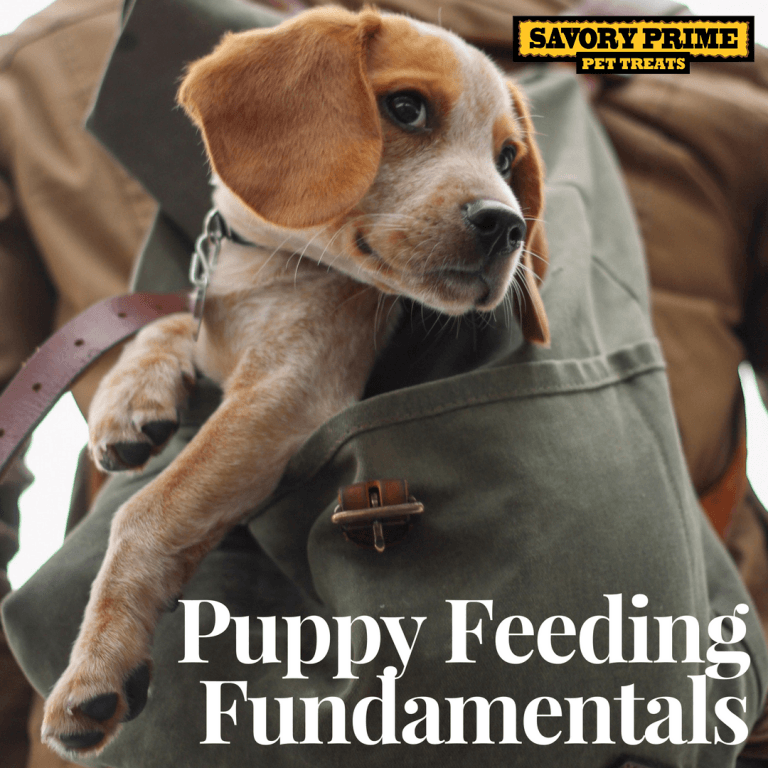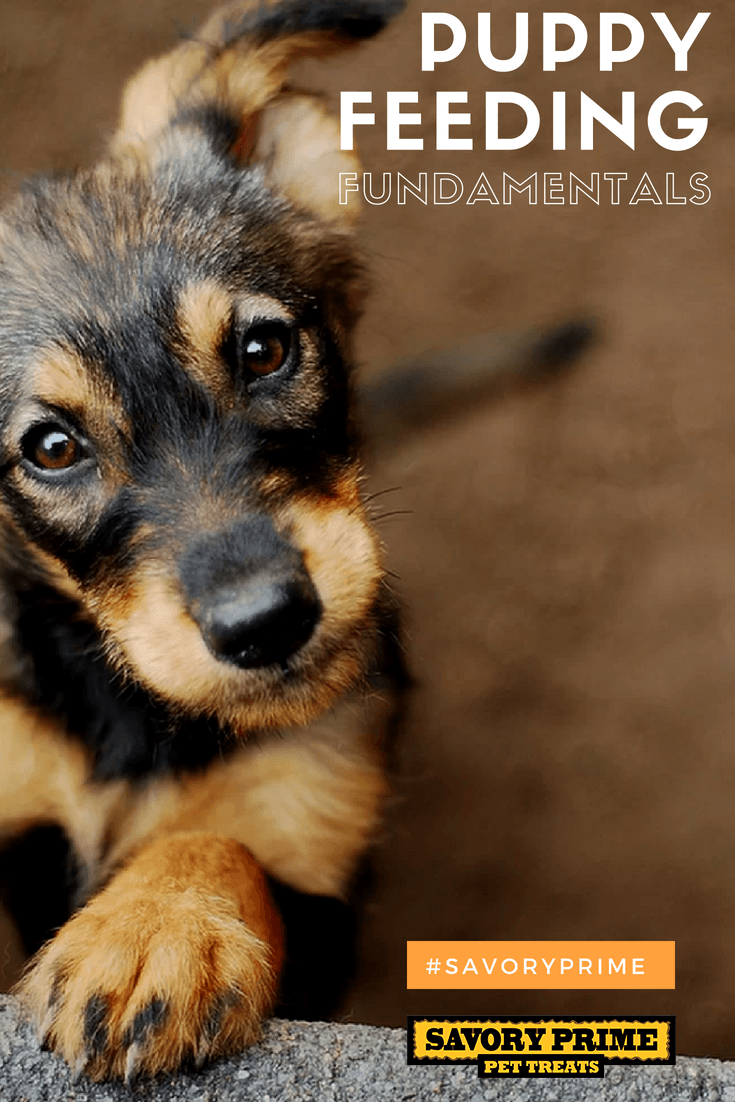Walk down the dog food aisle of any large pet-supply store, or peruse the shelves at a boutique pet-food shop, and you can quickly become overwhelmed. This is especially true for puppy owners, and probably even more so for first-time puppy owners. When did it get so complicated? Back in the day, dog food options were far more limited, and even responsible dog owners didn’t worry too much about what went into their dog’s dish.
The process may now be somewhat more involved, but that’s a good thing. Higher quality ingredients with better sourcing and specialized diet formulas lead to overall better health for our puppies. And every bit as important as what to feed your puppy is having an understanding of his special nutritional needs.
All puppies are different, so if you have any concerns or questions about your puppy’s food, feeding schedule, or nutritional health, always consult your breeder or veterinarian—that’s what they’re there for.
Many puppy owners wonder, “How long should I feed puppy food?” Here is a general timeline for what your puppy needs at each stage of his first year of life.
Feeding Your Puppy: A First-Year Timeline
- 6–12 weeks: Growing pups should be fed puppy food, a diet specially formulated to meet the nutritional needs for normal development. Feeding adult food will rob your puppy of important nutrients. Four feedings a day are usually adequate to meet nutritional demands. Large breeds should be fed unmoistened dry food by 9 or 10 weeks; small dogs by 12 or 13 weeks.
- 3–6 months: Sometime during this period, decrease feedings from four to three a day. A pup should be losing her potbelly and pudginess by 12 weeks. If she is still roly-poly at this age, continue to feed puppy-size portions until body type matures.
- 6–12 months: Begin feeding twice daily. Spaying or neutering lowers energy requirements slightly; after the procedure, switch from nutrient-rich puppy food to adult maintenance food. Small breeds can make the switch at 7 to 9 months; bigger breeds at 12, 13, even 14 months. Err on the side of caution: Better to be on puppy food a little too long than not long enough.
- After age 1: Most owners feed adult dogs two half-portions a day.
How much food should I give my puppy?
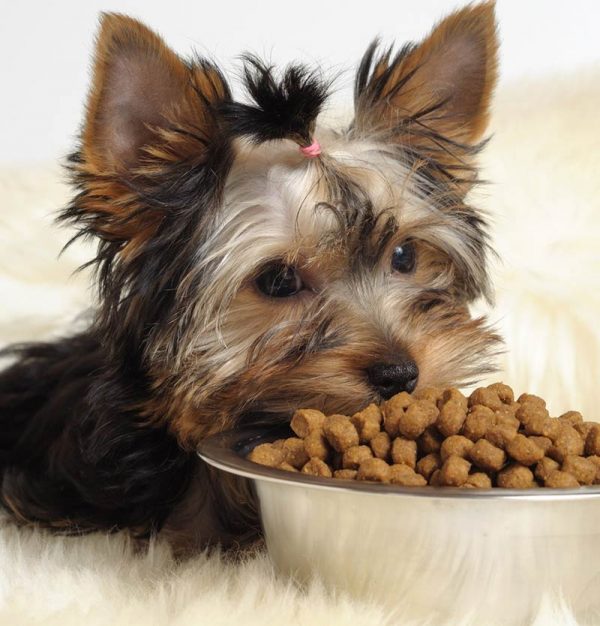
Also, if you are doing treat-based training with your pup, adjust the amount you feed at mealtime accordingly. Whenever training with treats, keep the treat as small as possible.
How often should I feed my puppy?
Like human babies, puppies start out needing many small meals a day, of a food formulated for their special nutritional requirements. Most, but not all, dogs finish meals quickly. To discourage picky habits, feed at regular times in regular amounts and don’t leave food down for more than 10 to 20 minutes.
Your breeder will be an excellent source of guidance for both of these questions, as will your vet.
Is it worth it to buy the more expensive stuff?
Premium food has higher nutritional density, so you can feed your dog less to achieve the same results. Also, premium foods have stable ingredient profiles; the composition of bargain brands can vary from batch to batch.
The major dog-food companies invest heavily in product development and research, constantly upgrading formulas to keep up with their competitors. This means that feeding premium food puts you on the cutting edge of canine nutrition.
Dry Food, Wet Food, or Both?
Many pet-food companies have worked with canine-nutrition scientists to develop special formulas for both large- and small-breed puppies.
- Canned food is the most expensive to feed, and dogs often find it most palatable. Be careful of “all-meat” claims, though. Your dog should have a complete, balanced diet to fulfill nutritional requirements. Meat alone may not do it.
- Semi-moist food is available in one-serving packets. It is usually made to look like hamburger.
- Kibble is the most economical, and the major makers offer a complete and balanced diet for dogs of all sizes and ages. Dry food can be fed exactly as it comes from the bag.
Some dog owners say there is an oral-hygiene advantage in hard kibble because the friction produced helps to keep the gums and teeth healthy. Kibble can be moistened, either with water or canned food. Although unnecessary, that addition may make food tastier.
Food For Big Puppies & Little Puppies
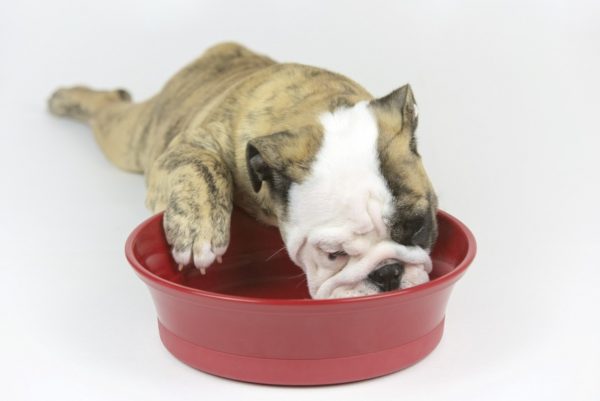
Best food for small-breed dogs
Best food for large-breed dogs
Chart Your Puppy’s Weight and Growth
There are growth-and-weight charts available in print and online. Weigh the puppy weekly and record his progress, comparing him to breed-appropriate weight charts. Adjust his food intake to achieve an average rate of growth.
Weighing a dog, even a squirming puppy, is easy. Just weigh yourself, then weigh yourself holding the puppy. Subtract the difference—that’s the puppy’s weight. Voila!
Don’t worry about an ounce or two either way; no two dogs, even within breeds, are built exactly alike.
A young dog carrying too much weight has an increased risk of orthopedic problems, due to stress on immature joints. Obesity can also lead to diabetes, diseases of the heart and other organs, and general lethargy.
Hold the fries
One little French fry will invariably lead to another, and another. Before long, an obese dog will be crowding you off the love seat. Also, a steady diet of table scraps can create a nutritional imbalance, and certain ingredients and spices in your favorite dishes can cause upset stomach in dogs.
The pleading gaze of a begging dog can be irresistible. This is no accident. During his long partnership with man, the dog has perfected cunning methods of exploiting the human habit of associating food with affection. In prehistoric times semi-domesticated canines first cultivated human beings as a food provider. As the two species grew closer, dogs modified begging behaviors to maximize results: The more pathetic a dog seemed, the more scraps were tossed his way. Dogs have since refined this approach into a low-risk, high-reward hunting technique.
But don’t be fooled: Begging is not an emotional crisis or a test of your love. It’s what scientists might call an evolutionary survival strategy, or what the rest of us might call a scam. Allowing your dog to guilt you into overfeeding him, or serving him a steady diet of table scraps in a misguided show of affection, can have harmful or even fatal results.
Puppy Feeding Tidbits
- Feeding your pup the moment you get home may encourage separation anxiety. Play or grooming is a more positive way to say hello.
- When medically necessary, you can purchase canned or dry prescription diets from veterinarians to feed dogs with kidney disease, heart disease, diabetes, and other serious conditions. These foods should never be fed without a prescription.
- Some vitamin or mineral supplements, when utilized incorrectly (such as extra calcium given to a large-breed dog on a good diet), will do more harm than good.
- Before making a major change in your dog’s diet, consult with your veterinarian and, when possible, the breeder. Once the formula is chosen, stick with it. Sudden changes in food may cause digestion problems.
- Small portions of carrot or apple chunks are healthful low-calorie snacks most dogs love.
- Fresh water should be available at all times. During the summer months, consider setting up multiple indoor/outdoor water stations. To avoid a buildup of bacteria, wash the water bowl daily.
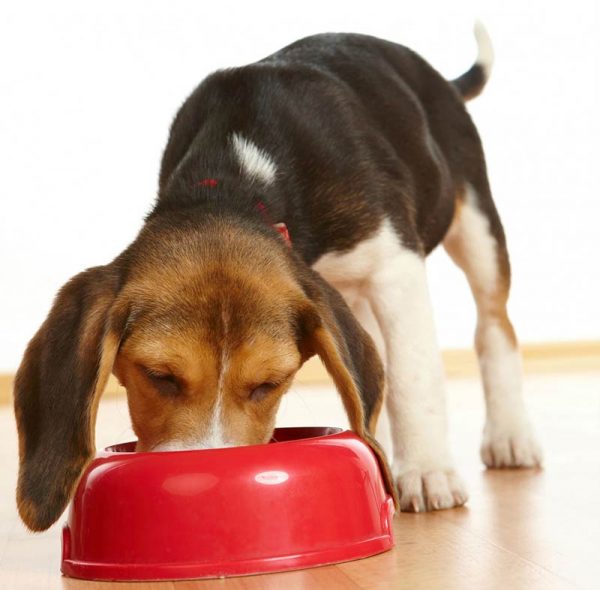
When switching from puppy food to adult food, you should make the switch gradually over a period of a few days. A sudden change in your dog’s diet may cause stomach upset. Talk to your veterinarian about the best type of food for your dog.
Final Thoughts
* Make sure everyone gets with the program!
Your entire household must be committed to your dog’s feeding regimen. If there’s a soft touch for a handout in your family, your dog will find it and exploit it, thus undoing the good you are trying to do. Keeping a dog trim takes a conscious effort from everyone on your team. And remember: There is room for only one alpha dog in your house, and that’s you. Allowing a dog to beg at the table undermines your status as pack leader, resulting in training and behavior problems.
* Give a dog a bone? Careful!
Our best advice here is caution. Poultry and pork bones, or cooked bones of any kind, are strictly forbidden. They splinter into shards that can cause choking and serious damage to the dog’s mouth, throat, or intestines. Any bone, in fact, once chewed into small pieces, can block the intestines and lead to a nasty bout of constipation, can cause lacerations of the mouth and internal organs, or can lodge in the throat with fatal results. It is important to note that bones have little if any nutritional value.
There are other ways to satisfy a dog’s craving to chew. Commercially available chew toys andd simulated bones are made for dogs of all sizes.
As the famous food writer M.F.K. Fisher wrote, “First we eat. Then we do everything else.” This is true for our pups, too.
Recent Pet Posts
Blog Categories
Product categories
- Accessories (7)
- Chicken & Veggie Wraps (8)
- Grillers Jerky Tenders (4)
- Jerky Treats (10)
- Made in the USA (9)
- Non-Rawhide Treats (28)
- Beggar Bone (11)
- Bully Sticks (4)
- Butcher Bone (4)
- Cod Skin Fish Treats (3)
- Pork Skin Twists (2)
- Pressed Rawhide Bones & Rolls (16)
- Bones & Rolls (6)
- Pressed Rawhide Bulk (6)
- Twist Sticks (4)
- Savory Munchies (13)
- Supreme Bones & Rolls (48)
- American Rawhide Bulk (16)
- Rawhide Bones (14)
- Rawhide Chips (6)
- Rawhide Rolls & Sticks (12)
- Uncategorized (8)

